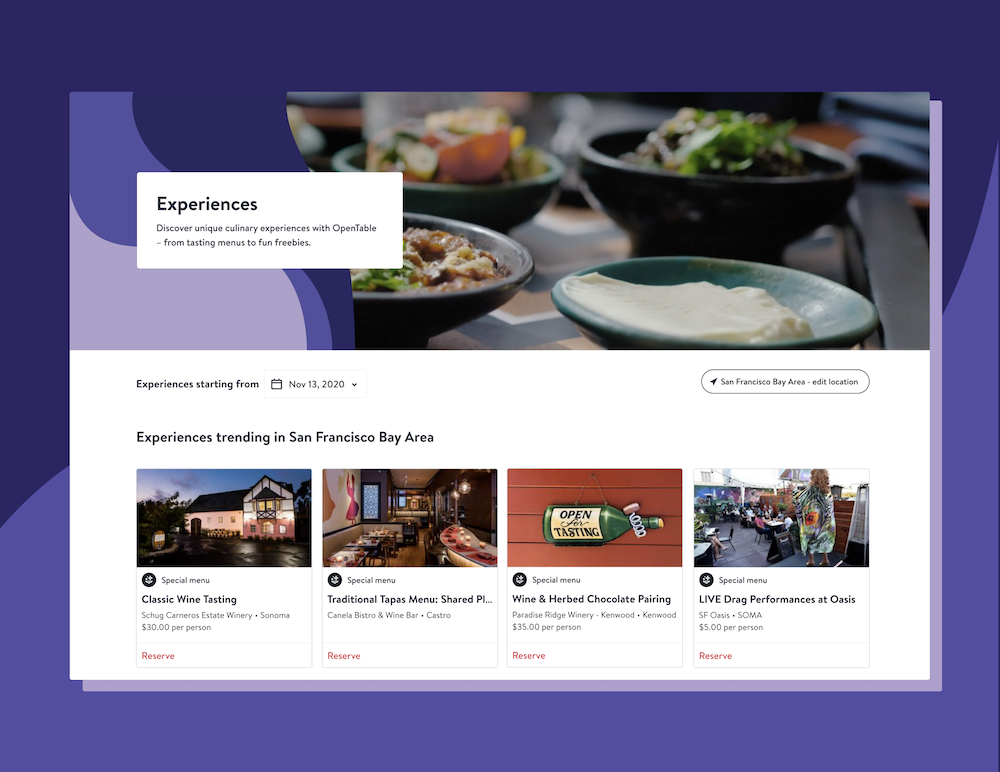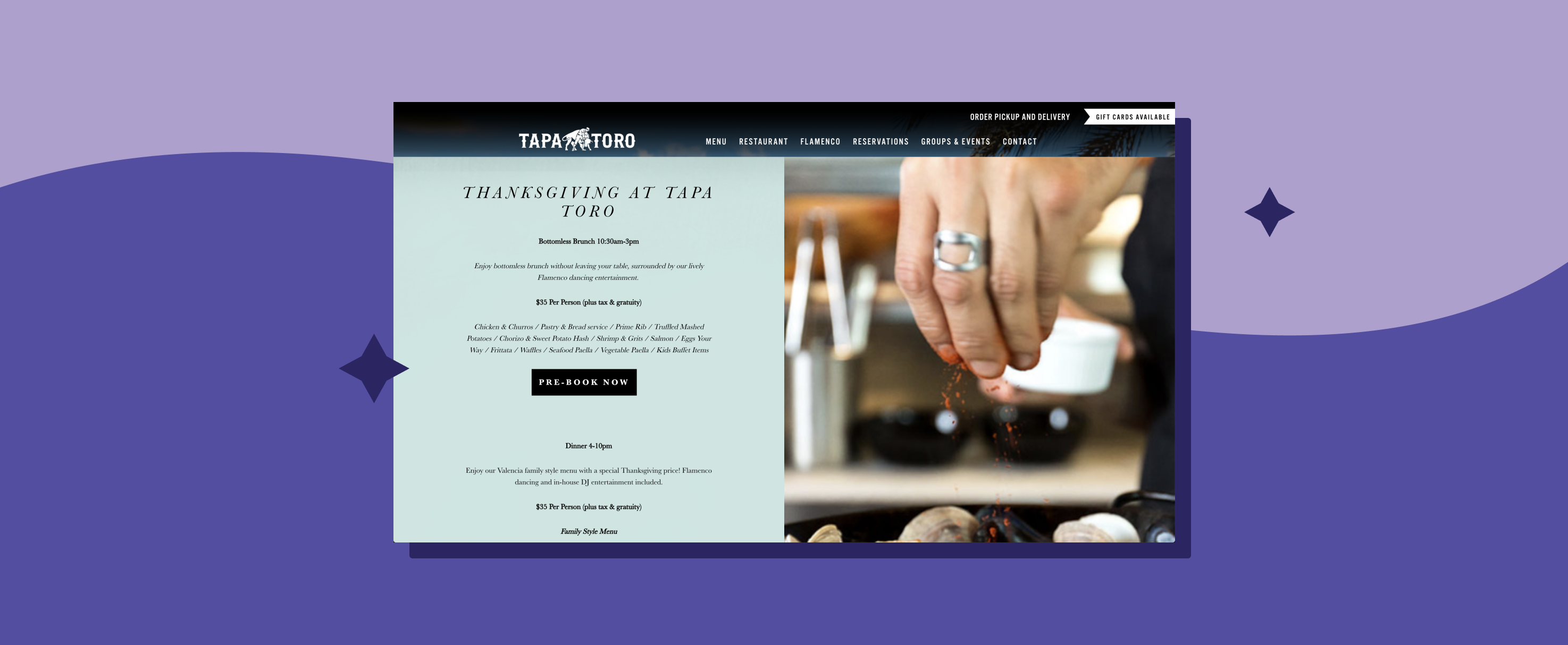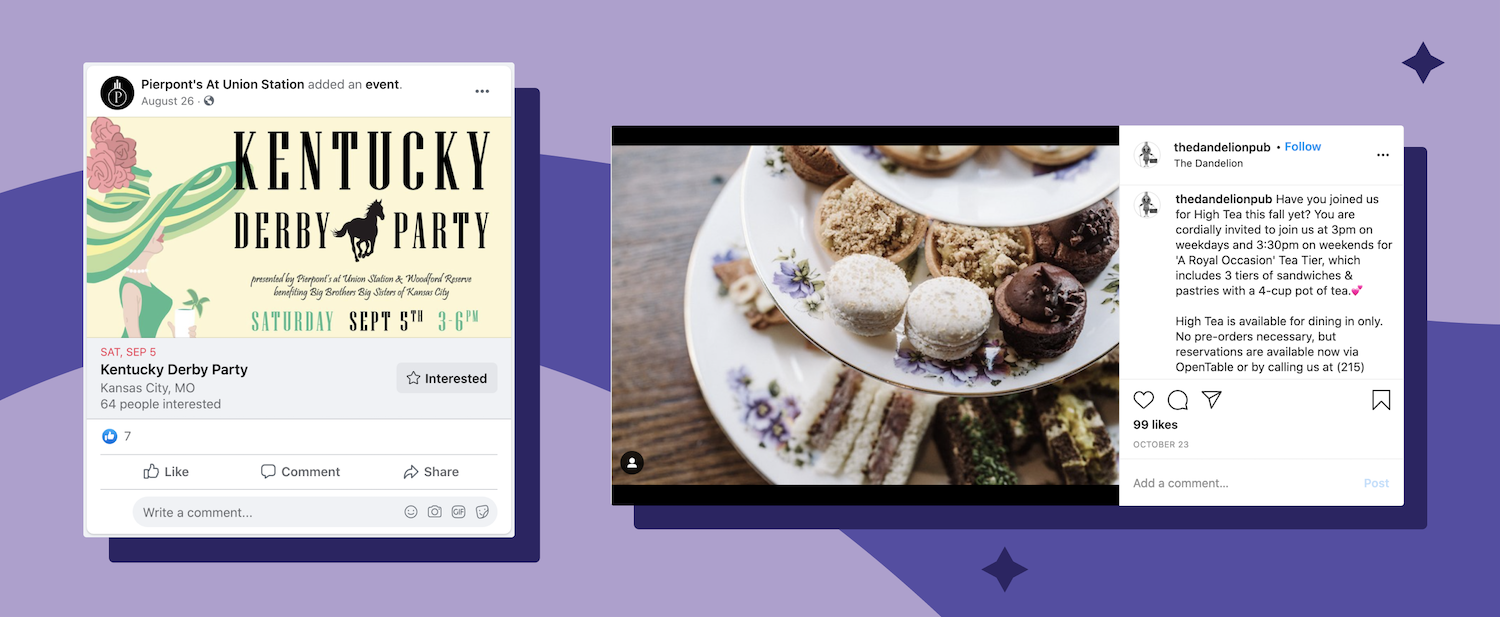You’ve created your experience and now it’s time to get the word out and bring diners in. Promote your experiences across all of your marketing channels: Highlight them on your website with your OpenTable booking widget, email them to prior guests and VIPs with your offerings, promote them across your social channels, and mention them in your in-restaurant marketing materials.
Here are six sure-fire ways to promote and market your experiences to new and existing guests.
1. Stand out on OpenTable
Add your experiences on OpenTable to get exposure on the new dedicated Experiences lists and collections. Plus, ongoing OpenTable marketing campaigns highlighting unique experiences to diners may feature your experience.
Diners can browse Experiences in their area, explore trending special menu Experiences from the OpenTable homepage, and book directly from the Experiences section on your restaurant profile.
“We put the bottomless brunch special on OpenTable as an Experience so it would be seen by people looking for reservations and help them choose to come to our restaurant,” says Levin at Tico D.C. “It has helped to really turn it into one of the most successful services in terms of reservations.”

OpenTable dedicated Experience discovery page on OpenTable.com
OpenTable boost campaigns
To get more exposure for your experience, simply add a boost campaign on the web or using the iOS Owner’s app by applying a start date, end date, and shift schedule that aligns with the days and shifts of your experience. On average, restaurants that run OpenTable campaigns for the first time see a 39% increase in impressions, based on OpenTable network data for restaurants that used OpenTable marketing for the first time between January and December 2019.
Learn more about OpenTable boost campaigns.
2. Highlight experiences on your website

Tapa Toro in Orlando showcases their Experiences on their website, with direct links for guests to book
To give your experiences a spotlight, highlight your experiences front and center on your website. Consider creating a special page to highlight ongoing or upcoming experiences and events. Include photos and detailed descriptions of what guests can expect. Add custom booking links to your experience descriptions to help guests discover and book your experiences.
On your website, you can also capture interest (and email addresses) from engaged guests to send experience-specific newsletters and communications. Guests who request this information are not only a captive audience, but are also more likely to book your experience.
For more tips on how to build the ultimate restaurant website, check out our guide.
3. Connect with (and target) engaged guests via email
Though there are many avenues to marketing your experiences, you’ll likely see the highest conversion and the most impact from your existing guests, since they’re already engaged with your restaurant. Email is the fastest and easiest way to connect with those loyal guests.
Collecting guest preferences not only helps your team tailor the best experience for you guests in the dining room, but these preferences can also help you design highly targeted and highly relevant emails. Guests who have shown a keen interest in red wine will likely be interested in a Barolo wine dinner. Just as guests who always order a chocolate dessert may be interested in a chocolate baking class.
Consider building targeted audience email lists, and offering them first dibs to book your experience. By limiting the audience to a targeted group, you reduce the number of email blasts to your entire list and hopefully increase your conversion rate. Targeted emails also make guests feel special and known, which translates to engaged and loyal customers.
As with an email nurture series, when you connect your email marketing tools such as Mailchimp, Fishbowl, or Emma with OpenTable, you can target customers based on guest preferences, visit frequency, and even average spend. Learn how to integrate your email marketing system with OpenTable.
4. Share your experience on social media

Pierpont’s at Union Station and The Dandelion promote their experiences on Facebook and Instagram.
As with all social media posts, people are hungry for crave-worthy food shots and an inside peek into your upcoming experiences. They want to know the vibe of your restaurant and get a taste of your cuisine. Behind-the-scenes photos and videos of chefs and kitchen staff preparing for experiences are a great way to give people an insider view. Tap into the social conversation and make your experience more discoverable by using relevant hashtags for your experience.
Promote your event on social media using a customized experience booking link. Tip: Add marketing tracking so you can tie your reservations and revenue from experiences promoted on your social channels).
Encourage guests who enjoy your experiences to share their take on social media (and tag you when they do) to build community and create word-of-mouth marketing. Be sure to thank guests who engage with you on social media.
5. Communicate before and after the experience
Two weeks before your Experience, you may need some extra marketing love to sell out, especially for pre-paid experiences. This is the perfect time to send a reminder email to guests who have yet to book.
In addition to emailing guests who’ve already booked the experience, you can also start a boost campaign two to three weeks in advance to give your restaurant more exposure. Or, if you’re light on reservations in the days leading up to your experience, you can start a targeted campaign to reach same-day bookers and last-minute guests.
Your relationship with guests doesn’t end when the experience is over. The days following the experience is a great time to gauge guests’ satisfaction with your experience, as well as solicit dining reviews and promote upcoming experiences they might enjoy.
6. Leverage connections with guests in the dining room (yours or theirs)
Finally, remember to promote your upcoming experiences with guests when they dine with you. Printed materials such as exterior and interior signs, check presenter inserts, and table tents are great ways to bring attention to your experiences. Even better: talk about them with your guests. Encourage your staff to mention upcoming experiences—even run a contest to see who can sell the most tickets.
And just because a guest enjoys your food at home doesn’t mean you can’t tell them about an experience in the dining room. Add experience flyers or postcards to your takeout bags or stickers on your to-go packaging to entice your guests with a special meal out.
Learn more about showcasing unique experiences on OpenTable
Already an OpenTable customer? Start using Experiences.




